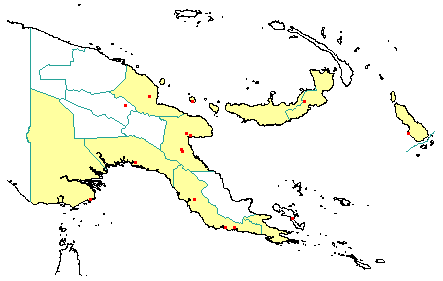
in PNGplants database
PNGTreesKey – Antiaris toxicaria (Pers.) Lesch. var. macrophylla (R.Br.) Corner |
Barry Conn (NSW) & Kipiro Damas (LAE).
Guide to trees of Papua New Guinea
Copyright held by the authors, National Herbarium of New South Wales, and Papua New Guinea National Herbarium
Gardens' Bulletin, Singapore Vol. 19: 248 (1962)
Other Literature: W.-L. Chew, Flora of Australia 24-26 (1989) Fig. 29 (D & E).
Family: Moraceae
Dicotyledon
Timber Group: Commercial hardwood
Field Characters: Large canopy tree (occasionally up to 40 m high) or Small sub-canopy tree (up to c. 25 m high); Bole cylindrical (up to c. 40 cm diam.); straight (bole up to 25 m long); buttresses buttresses present; spines spines absent; aerial roots aerial roots absent; stilt roots stilt roots absent; Bark pale brown, white, or grey, smooth or slightly rough, pustular, lenticels elongated vertically; Subrhytidome (under-bark) yellow or green (yellowish green); less than 25 mm thick, 10.0-25.0; bark blaze consisting of one layer; strongly aromatic; pleasant; outer blaze white or grey (straw-coloured), markings absent, very fibrous; inner blaze white or grey (straw-coloured), markings absent, very fibrous; bark exudate (sap) present, white/milky, flowing, colour changing on exposure to air, to grey (greyish white), sticky; terminal buds enclosed by leaves.
Indumentum: Complex hairs absent; stinging hairs absent; mature twig indumentum (hairs) present, hairs dense.
Leaves: Leaves spaced along branches, spiral (leaves occurring singly at a node and arranged spirally up the branchlet), simple (a leaf composed of a single blade); petiole present, winged, attached to base of leaf blade, not swollen; leaves broadest above middle or broadest at or near middle, 11.0-21.0 cm, 4.5-8.0 cm; symmetric, serrate to dentate (toothed), not dissected or lobed, acuminate, venation pinnate, secondary veins open, prominent, intramarginal veins absent; leaves lower surface green or pale green, upper surface dark green (glossy to subglossy), indumentum (hairs) present, indumentum (hairs) somewhat dense or sparse; absent; domatia absent; stipules present, free, laterally placed, encircling the twig (partially) or not encircling the twig, collar-like, fringed, large, not persistent.
Flowers: Inflorescence axillary, flowers single, flowers arising from a single point (female inflorescences 1 or 2-flowered), or flowers on an unbranched axis (male inflorescences), cones absent; flowers unisexual, unisexual with male and female flowers on the same plant, not stalked (male flowers) or stalked (female flowers), flowers with many planes of symmetry, 1.0-5.0 mm long, diameter small (up to10 mm diam.) (female flowers c. 4 mm diam., male flowers up to c. 1 mm); perianth present, with all sepals and/or petals (hence tepals) similar, inner perianth pale green or grey (pale almost translucent); 2-(female flowers with 4 perianth parts)-7, free; stamens 2-(male flowers)-4, absent, free of each other, free of the perianth; ovary inferior, carpels solitary, locules 1; styles free (reduced to stigmas), 2.
Fruits: Infrutescence usually single or arising from single point (rarely 2 fruits), fruit 25.0-35.0 (-40.0) mm long, 15.0-25.0 mm diam., orange or dark red, not spiny (covered with velvety hairs), fleshy, simple, indehiscent, drupe; seeds 1, about 10 mm long, not winged, broad (as wide as long), seed 1-10 mm diam.
Distribution: Madang, Morobe, Western, Gulf, Central, Milne Bay, New Britain & Bougainville.
 | Botanical records in PNGplants database |